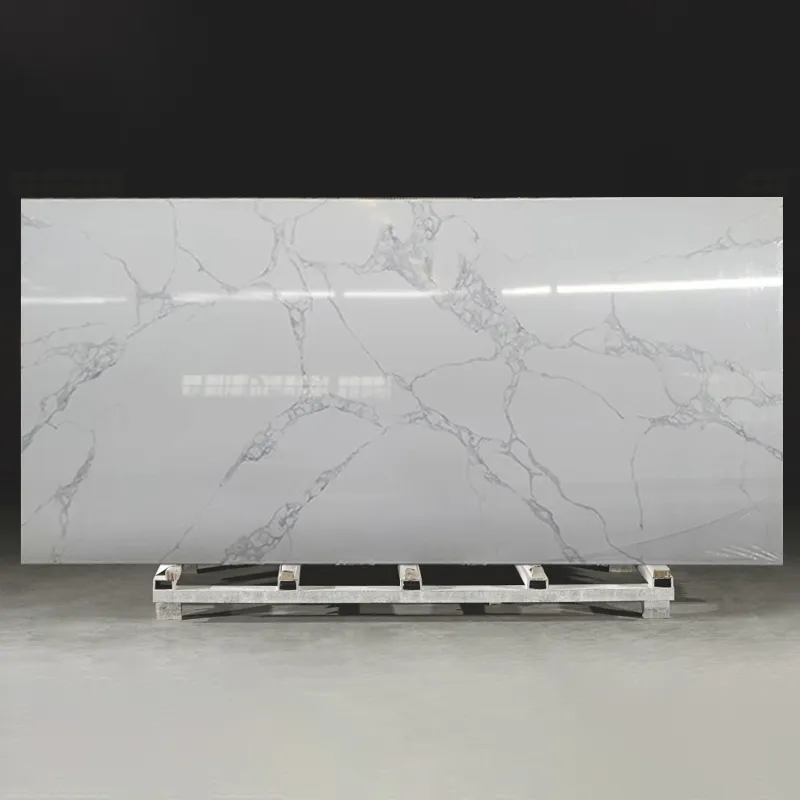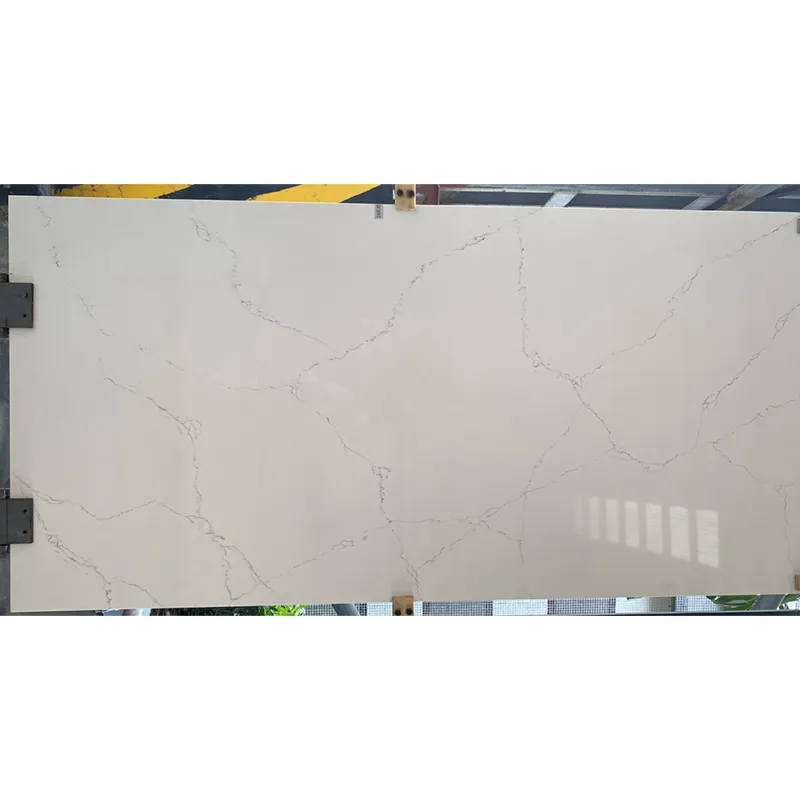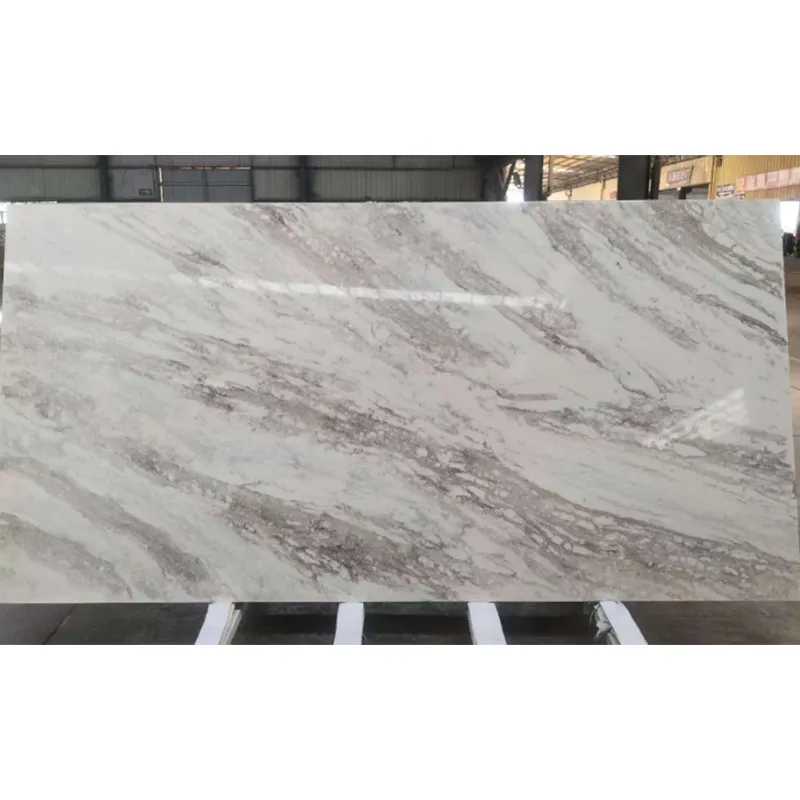Calacatta quartz countertops are widely used in modern kitchens and bathrooms for their high-end, luxurious appearance and excellent durability. However, despite its superior stain and scratch resistance, some dark spots or stains may still appear after a period of use. These dark spots are usually caused by a variety of reasons, including food residue, oil, long-term exposure to chemicals, or surface damage caused by improper cleaning methods.
Although calacatta quartz countertops are more durable and less likely to absorb stains than natural stones such as marble, they can still be damaged if not properly maintained and cleaned. This article will discuss in detail how to fix dark spots on calacatta quartz countertops to help consumers effectively solve this problem and restore the beauty and functionality of the countertop.

Understanding the materials and characteristics of calacatta quartz countertops
The calacatta quartz countertop is a composite material synthesized from natural quartz, resin, and pigment. As one of the most common minerals on earth, quartz has a high hardness and can provide excellent durability for countertops. Quartz countertops are more stain-resistant and scratch-resistant than natural marble or granite, but their surfaces may still develop some stains or dark spots after long-term use.
Dark spots usually appear in some areas of the countertop surface. These spots are often caused by the surface not being cleaned in time or reacting with certain substances. In order to effectively repair these dark spots, we need to first understand their sources and the factors that affect the appearance of the calacatta quartz countertop.
What causes dark spots on calacatta quartz countertops?
There may be many reasons for dark spots on calacatta quartz countertops. Common factors include the following:
1. Grease or food residue penetration
Although quartz countertops have good stain resistance, substances such as grease, sauces, coffee, and juice may still penetrate and leave marks if they stay on the surface for a long time. Especially those sticky or dark-colored foods can easily leave marks on the countertop and form dark spots.
2. Chemical corrosion
Certain strong acidic or alkaline cleaning agents, or daily chemical products (such as bleach, detergent, etc.), if in contact with the countertop surface for too long, may cause damage to the resin layer, leaving dark spots that are difficult to remove. This damage usually occurs when cleaning is not done in time and chemicals are not used correctly.
3. Improper use of cleaning tools
Using a hard brush or cleaning cloth, especially a cleaning cloth with sand particles, can scratch the quartz countertop, leaving fine scratches or dark spots. In addition, certain high-temperature objects in contact with the countertop may also cause slight burn marks on the surface, resulting in the appearance of dark spots.
4. Physical damage
During the use of calacatta quartz countertops, physical damage may occur, including scratches, burn marks, collision marks, etc. These damages not only affect the appearance of the countertop, but may also cause color differences or the formation of dark spots.
5. Water stains and mineral deposits
Minerals in water (such as calcium and magnesium) may leave water stains and dark spots on the surface after prolonged contact with calacatta quartz countertops. These types of dark spots usually appear on the edge of the countertop or around the sink.

How to fix dark spots on a calacatta quartz countertop?
Fixing dark spots on a calacatta quartz countertop can usually be done in a few steps. Depending on the type and cause of the dark spot, the right method can effectively remove or lighten the marks on the countertop.
1. General cleaning and stain removal
If the dark spot is caused by everyday dirt such as oil, food residue or water stains, the easiest way is to use a mild detergent for general cleaning.
Step 1: Clean the surface
Use warm water and a mild neutral detergent (such as dishwashing liquid) mixed with a soft cloth and gently wipe the surface of the countertop. For grease stains, you can use a mixture of warm water and a small amount of baking soda to remove them.
Step 2: Rinse and dry
Rinse the surface with clean water to ensure that all detergent residue is completely removed. Then, use a clean soft cloth to wipe the countertop dry to avoid water spots or mineral accumulation.
2. Use a quartz countertop cleaner
If regular cleaning methods don't completely remove the dark spots, consider using a cleaner designed specifically for quartz countertops. These cleaners are usually gentle and can effectively remove stubborn stains on calacatta quartz countertops.
Step 1: Choose the right cleaner
There are some special cleaners on the market for quartz countertops. These products usually contain stain removers that can effectively remove oil stains, stains, and light deposits.
Step 2: Apply the cleaner
Spray the cleaner on the dark spots and gently wipe with a soft cloth or sponge. Be careful not to use a hard brush or rough cloth to avoid scratching the countertop.
Step 3: Rinse and wipe dry
Rinse the cleaner thoroughly with clean water to ensure that no residue is left on the surface, then wipe dry with a clean cloth.
3. Remove water and mineral deposits
If the dark spots are caused by water or mineral deposits, you can try using a cleaner designed to remove water and mineral deposits. These cleaners can effectively remove scale and mineral deposits from the countertop surface, restoring a smooth surface.
Step 1: Apply a spot remover
Apply an appropriate amount of spot remover to the dark spot and let it sit for a few minutes to allow the cleaner to penetrate and soften the deposits.
Step 2: Wipe and remove
Use a soft cloth or sponge to gently wipe to remove water stains and mineral deposits. If the stain is stubborn, you can repeat this process.

4. Repair small scratches and surface damage
For deeper scratches or damage, you can use a quartz countertop repair kit for repair. These repair kits usually include special resin fillers and polishing tools that can effectively repair small scratches or burn marks on the countertop surface.
Step 1: Clean the surface
Before starting the repair, clean the countertop surface thoroughly with a mild detergent.
Step 2: Fill the scratch
Follow the instructions in the repair kit and fill the scratch or surface damage with a special resin filler, making sure the filler is evenly applied and wipe off the excess.
Step 3: Polish the repaired area
Use fine sandpaper or a polishing tool to polish the repaired area to make it level with the surrounding surface and restore the gloss of the countertop.
5. Regular maintenance and prevention
In order to avoid recurring dark spots and stains on the calacatta quartz countertop, regular maintenance is very important.
● Regular cleaning: Use a mild detergent to clean the countertop regularly to prevent stains from staying on the countertop for a long time. For areas that are frequently used, it is recommended to clean once a week.
● Use anti-fouling agents: Some anti-fouling agents specifically for calacatta quartz countertops can form a protective film on the surface of the countertop to help reduce the penetration of stains and extend the service life of the countertop.
● Avoid contact with high temperatures and chemicals: Try to avoid direct contact between high-temperature objects and the countertop, and avoid using strong acid or alkaline cleaners to avoid damaging the countertop surface.
Rongguan stands out as a leading manufacturer of artificial marble, quartz countertops, and premium roof tiles. With advanced production lines and an experienced technical team, we offer high-quality products tailored to your specifications. Partner with us for bulk purchases and take advantage of our factory-direct discounts and customized quotes.

